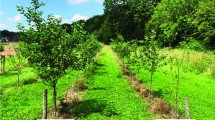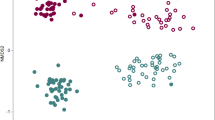Abstract
Apple replant disease (ARD) is a soil-borne disease complex that affects young apple trees in replanted orchards, resulting in stunted growth and reduced yields. Newly developed rootstock genotypes with tolerance to ARD may help to control this disease. We determined the effects of rootstock genotype rotations during orchard renovation, by investigating root-zone soil microbial consortia and the relative severity of ARD on seven rootstock genotypes (M.9, M.26, G.30, G.41, G.65, G.935, and CG.6210) planted in soil where trees on four of those same rootstocks (M.9, M.26, G.30 and CG.6210) had grown for the previous 15 years. Rootstock genotyping indicated that genetic distances among rootstocks were loosely correlated with their differential responses to ARD. Root-zone fungal and bacterial community composition, assessed by DNA fingerprinting (T-RFLP), differed between M.26 and CG.6210. Soil bacterial communities were influenced most by which rootstock had grown in the soil previously, while fungal communities were influenced more by the current replanted rootstock. In a clone library of bacteria from M.26 and CG.6210 root-zone soil, β-Proteobacteria was the most abundant phylum (25% of sequences). Sequences representing the Burkholderia cepacia complex were obtained only from CG.6210 soil. Rootstock genotypes that were grown in the orchard soil previously affected subsequent ARD severity, but replanting with the same or closely related rootstocks did not necessarily exacerbate this disease problem. Our results suggest that genotype-specific interactions with soil microbial consortia are linked with apple rootstock tolerance or susceptibility to ARD.



Similar content being viewed by others
Abbreviations
- AMMI:
-
Additive main effects with multiplicative interaction
- ANOVA:
-
Analysis of variance
- ARD:
-
Apple replant disease
- OTU:
-
Operational taxonomic units
- T-RFLP:
-
Terminal restriction fragment length polymorphism
References
Benizri E, Piutti S, Verger S, Pagès L, Vercambre G, Poessel JL, Michelot P (2005) Replant diseases: bacterial community structure and diversity in peach rhizosphere as determined by metabolic and genetic fingerprinting. Soil Biol Biochem 37:1738–1746
Bevivino A, Dalmastri S, Tabacchioni S, Chiarini L (1998) Efficacy of Burkholderia cepacia: effects of seed treatment on disease suppression and growth promotion of maize. FEMS Microbiol Ecol 27:225–237
Bruns T, White TJ, Taylor JW (1991) Fungal molecular systematics. In: Johnston RF (ed) Annual review of ecology and systematics. Annual Reviews Inc., Palo Alto, pp 525–564
Časka V, Vančura V, Hudská G, Přikryl Z (1982) Rhizosphere micro-organisms in relation to apple replant problem. Plant Soil 69:187–197
Chan C, Yang X, Fu Y, Feng Z, Sha L, Casper P, Zou X (2006) 16S RNA gene analyses of bacterial community structures in the soils of evergreen broadleaved forests in southwest China. FEMS Microbiol Ecol 58:247–259
Culman SW, Gauch HG, Blackwood CB, Thies JE (2008) Analysis of T-RFLP data using AOV and ordination methods: a comparative study. J Microbiol Meth 75:55–63
Cummins JN, Aldwinckle HS (1974) Breeding apple rootstocks. HortScience 9:367–372
De Clercq D, van Trappen S, Cleenwerck I, Ceustermans A, Swings J, Coosemans J, Ryckeboer J (2006) Rhodanobacter spathiphylli sp nov., a gammaproteobacterium isolated from the roots of Spathiphyllum plants grown in a compost-amended potting mix. Int J Syst Evol Micr 56:1755–1759
Fazio G, Robinson TL, Aldwinckle HS, Mazzola M, Leinfelder M, Parra R (2005) Traits of the next wave of Geneva apple rootstocks. Compact Fruit Tree 38(3):7–11
Gauch HG Jr (2007) MATMODEL Version 3.0: Open source software for AMMI and related analyses. Cornell University, Ithaca, NY, 14853. Accessible at: http://www.css.cornell.edu/staff/gauch/matmodel.html
Gauch HG Jr, Furnas RE (1991) Statistical analysis of yield trials with MATMODEL. Agron J 83:916–920
Hebbar KP, Martel MH, Heulin T (1998) Suppression of pre- and postemergence damping-off in corn by Burkholderia cepacia. Eur J Plant Pathol 104:29–36
Hokanson SC, Szewc McFadden AK, Lamboy WF, McFerson JR (1998) Microsatellite (SSR) markers reveal genetic identities, genetic diversity and relationships in a Malus X domestica Borkh. core subset collection. Theoretical and Applied Genetics 97:671–683
Isutsa DK, Merwin IA (2000) Malus germplasm varies in resistance or tolerance to apple replant disease in a mixture of New York orchard soils. HortScience 35:262–268
Leinfelder M, Merwin IA (2006) Rootstock selection, pre-plant soil treatments, and tree planting positions as factors in managing apple replant disease. HortScience 41:394–401
Liebhard R, Gianfranceschi L, Koller B, Ryder CD, Tarchini R, Van De Weg E, Gessler C (2002) Development and characterization of 140 new microsatellites in apple (Malus x domestica Borkh.). Mol Breed 10:217–241
Mai WF, Abawi GS (1981) Controlling replant diseases of pome and stone fruits in Northeastern United-States by preplant fumigation. Plant Dis 65:859–864
Mai WF, Merwin IA, Abawi GS (1994) Diagnosis, etiology, and management of replant problems in New York cherry and apple orchards. Acta Hort 363:33–41
Manici LM, Ciavatta C, Kelderer M, Ershmaumer G (2003) Replant problems in South Tyrol: role of fungal pathogens and microbial population in conventional and organic apple orchards. Plant Soil 256:315–324
Marchesi JR, Sato T, Weightman AJ, Martin TA, Fry JC, Hiom SJ, Wade WG (1998) Design and evaluation of useful bacterium-specific PCR primers that amplify genes coding for bacterial 16S rRNA. Appl Enivron Microbiol 64:795–799
Matsushita A (1990) F-2702 a new antifungal antibiotic produced by Gluconobacter oxidans F2702 I. Taxonomy and production. Jikeikai Med J 37:325–334
Mazzola M (1998) Elucidation of the microbial complex having a causal role in the development of apple replant disease in Washington. Phytopathology 88:930–938
Mazzola M (1999) Transformation of soil microbial community structure and Rhizoctonia-suppressive potential in response to apple roots. Phytopathology 89:920–927
Mergaert J, Cnockaert MC, Swings J (2002) Fulvimonas soil gen. nov., sp. nov., a gamma-proteobacterium isolates from soil after enrichment on acetylated starch plastic. Int J Syst Evol Micr 52:1285–1289
Moeseneder M-M, Arrieta J-M, Muyzer G, Winter C, Herndl G-J (1999) Optimization of terminal-restriction fragment length polymorphism analysis for complex marine bacterioplankton communities and comparison with denaturing gradient gel electrophoresis. Appl Environ Microbiol 65:3518–3525
Nalin R, Simonet P, Vogel TM, Normand P (1999) Rhodanobacter lindaniclasticus gen. nov., sp. nov., a lindane-degrading bacterium. Int J Syst Bact 49:19–23
Norelli JL, Holleran HT, Johnson WC, Robinson TL, Aldwinckle HS (2003) Resistance of Geneva and other apple rootstocks to Erwinia amylovora. Plant Dis 87:26–32
Rom RC, Carlson RF (1987) Rootstocks for fruit crops. Wiley, NY, p 494
Rumberger A, Yao S, Merwin IA, Nelson EB, Thies JE (2004) Rootstock genotype and orchard replant position rather than soil fumigation or compost amendment determine tree growth and rhizosphere bacterial community composition in an apple replant soil. Plant Soil 264:247–260
Rumberger A, Merwin IA, Thies JE (2007) Microbial community development in the rhizosphere of apple trees at a replant site. Soil Biol Biochem 39:1645–1654
St. Laurent A, Merwin IA, Thies JE (2008) Long-term orchard groundcover management systems affect soil microbial communities and apple replant disease severity. Plant Soil 304:209–225
Wallace RB, Johnson MJ, Suggs SV, Ken-ichi M, Bhatt R, Keiichi I (1981) A set of synthetic oligodeoxyribonucleotide primers for DNA sequencing in the plasmid vector pBR322. Gene 16:21–26
Yao S, Merwin IA, Abawi GS, Thies JE (2006) Soil fumigation and compost amendment alter soil microbial community composition but do not improve tree growth or yield in an apple replant site. Soil Biol Biochem 38:587–599
Yoon JH, Kang SJ, Oh TK (2006) Dokdonella koreensis gen. nov, sp. nov., isolated from soil. Int J Syst Evol Micr 56:145–150
Author information
Authors and Affiliations
Corresponding author
Additional information
Responsible Editor: Hans Lambers.
Rights and permissions
About this article
Cite this article
St. Laurent, A., Merwin, I.A., Fazio, G. et al. Rootstock genotype succession influences apple replant disease and root-zone microbial community composition in an orchard soil. Plant Soil 337, 259–272 (2010). https://doi.org/10.1007/s11104-010-0522-z
Received:
Accepted:
Published:
Issue Date:
DOI: https://doi.org/10.1007/s11104-010-0522-z




